What happens to WordPress plugins if your theme is deactivated?
If you’ve ever changed your WordPress theme, you might have wondered what happens to the rest of your site, especially your plugins. Will they still work? Could you lose settings or functionality?
A common concern is whether WordPress deactivates a plugin if a theme is deactivated. The good news is your plugins don’t just disappear, but there are a few things you should know before hitting that deactivate button. Here’s what you need to know.
Key takeaways
Section titled Key takeaways- WordPress themes and plugins are separate – deactivating your theme won’t turn off your plugins.
- Most plugins continue to work normally, unless they rely on specific theme features like widget areas or custom templates.
- Switching themes can affect layout or styling, so always check how your plugins display after a theme change.
- Inactive plugins don’t slow your site, but outdated ones can pose security risks delete anything you’re no longer using.
- Back up your site before making changes using a plugin like UpdraftPlus, just in case anything breaks.
- Use a staging site to safely test theme changes without affecting your live site.
- After switching themes, test key functionality like forms, sliders, widgets, and mobile layout to catch any issues early.
What happens to plugins when a theme is deactivated
Section titled What happens to plugins when a theme is deactivatedChanging or deactivating your theme won’t break your plugins. In most cases, they’ll keep running exactly as they were.
WordPress treats themes and plugins as separate things. So even if your theme is deactivated, your active plugins will keep running like normal. Most plugins work independently of your theme, unless they were built to rely on it (which isn’t very common).
If you’ve manually deactivated any plugins, those will stay inactive until you turn them back on. But their files and settings stay on your site. So if you reactivate them later, they’ll usually pick up right where they left off.
Functionality risks when your theme changes
Section titled Functionality risks when your theme changesWhile most plugins work fine no matter what theme you’re using, there are a few exceptions where things might get a bit messy.
Some plugins rely on your theme for certain features like widget areas, custom templates, or specific styling. So if you deactivate your theme or switch to a new one, those features might not show up properly, or could look broken.
For example, if you had a plugin displaying content in a sidebar, and your new theme doesn’t have that sidebar, the content might just vanish from the page. Or if your old theme had custom styles for a form plugin, that form might now look completely different.
It’s not super common, but it’s worth checking your site after switching themes to make sure everything still works and looks the way you want.
What to test after switching themes
Section titled What to test after switching themes- Check key plugin features (contact forms, sliders, galleries, etc)
- Look for missing widgets or widget areas
- Make sure shortcodes are still working
- Review styling and layout for things like buttons and forms
- Test your menus and navigation
- Browse your site on mobile to spot any layout issues
Performance and security considerations
Section titled Performance and security considerationsDeactivating a theme won’t directly affect your site’s speed, but it’s still a good time to tidy things up.
Inactive plugins don’t run in the background, so they don’t slow your site down. But they can take up space in your database or backups, and clutter up your dashboard. More importantly, outdated or unused plugins (even if deactivated) can still pose a security risk if they’re not kept up to date.
It’s a good idea to review your plugins now and then. If you’re not using something and don’t plan to, it’s safer to delete it completely rather than leaving it sitting there.
If you’re switching themes or deactivating plugins, it’s always smart to back up your site first. That way, if anything breaks or doesn’t look right, you can easily roll back.
Best practices when deactivating a theme
Section titled Best practices when deactivating a themeChanging themes can be exciting, but it’s worth taking a few extra steps to make sure everything goes smoothly.
Here are a few best practices to follow:
- Back up your site first: This gives you a safety net in case anything breaks or looks off. A plugin like UpdraftPlus makes this quick and easy.
- Use a staging site if possible: Testing theme changes in a staging environment helps you catch issues before they go live.
- Check your layout and styling:
Again, check that everything on the front end is working correctly (widgets, layouts, etc) - Clean up unused plugins: If you’ve got inactive plugins lying around that you don’t plan to use, go ahead and delete them. It keeps your site faster and safer.
- Re-test important user journeys: Click through your most important pages like your contact form, shop, or blog posts to catch anything that’s gone missing or looks off.
How to switch to a new theme safely
Section titled How to switch to a new theme safelySwitching to a new theme is easy, but doing it the right way helps you avoid surprises.
Here’s how:
- Back up your site first (you knew we’d say it!) You can do this a couple of clicks with UpdraftPlus.
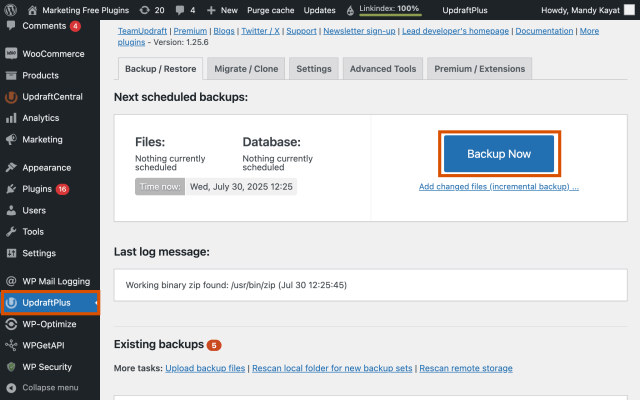
2. Go to Appearance > Themes
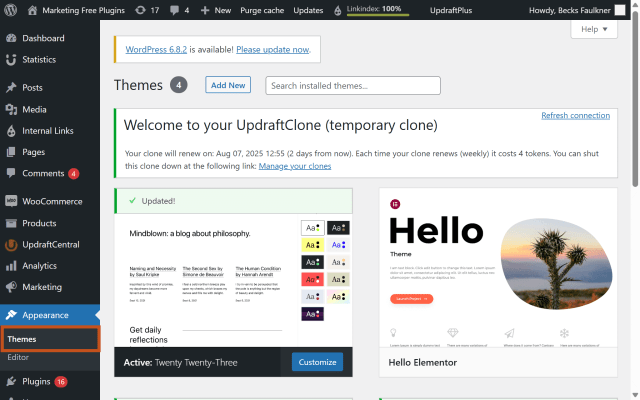
3. Click Add New to browse and install a new theme, or upload a .zip file if you’ve bought one elsewhere
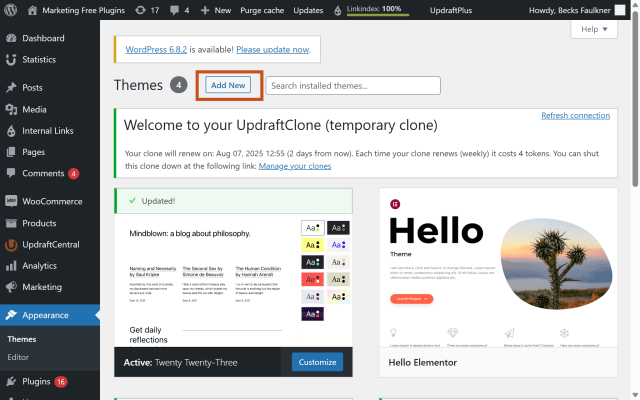
4. Once it’s installed, click Live Preview to check how your site will look
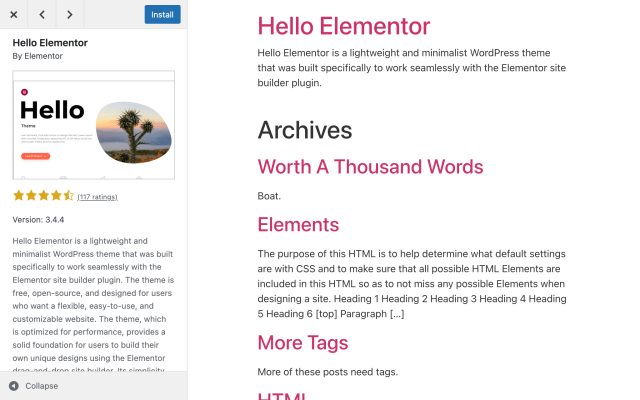
5. If you’re happy, click Activate
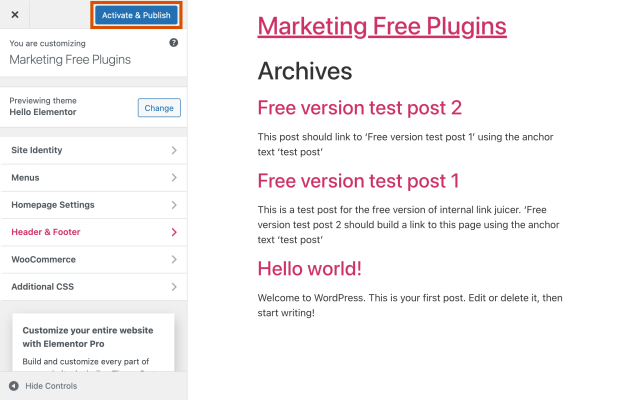
6. Review your site to make sure everything still works and looks good
Final thoughts
Section titled Final thoughtsDeactivating your WordPress theme won’t break your plugins, but it can still cause a few unexpected hiccups, especially if some features relied on the old theme’s layout or styling.
The key takeaway: WordPress doesn’t deactivate plugins if your theme is deactivated, but you should always double-check that everything still works the way you want. Test your site, clean up unused items, and back things up before making big changes.
Back up before making theme changes
Switching themes? Even small layout or styling changes can catch you off guard. With UpdraftPlus, you can quickly create a full backup before making changes so if anything goes wrong, you’re just one click away from restoring your site.
FAQs
Section titled FAQsWill WordPress deactivate plugins if my theme is deactivated?
No, WordPress doesn’t deactivate your plugins when you switch or deactivate a theme. Your active plugins will continue to run unless you manually turn them off.
Can plugins break when I change my theme?
Sometimes. If a plugin relies on your theme’s layout, styling or widget areas, switching themes can cause those features to disappear or look different.
Do I need to delete my old theme after switching?
Not necessarily. You can leave it installed in case you want to switch back. But if you’re sure you won’t use it again, deleting it can help tidy up your site.
Is it safe to change themes on a live website?
Yes, but it’s best to back up your site first and preview the new theme to avoid any surprises. If you can, test it on a staging site before going live.
Will I lose my content when I switch themes?
No, your posts, pages, and media stay the same. But layouts, widgets, and certain design elements might need to be adjusted depending on your new theme.
About the author

Dee Nutbourne
Dee is the Systems Operations Lead at Updraft WP Software. She’s worked in tech and with Updraft specifically, for 11 years. She was a developer for 8 years and has worked on plugins, themes and site management. Dee now manages our internal systems. She also helps with customer support and contributes to documentation, FAQs and guides.
Categories
UpdraftPlus
Get all our premium features. Direct site-to-site migration, incremental backups, back up automatically before updates and a whole lot more.
From just $70 for the year.
More stories
-

What’s new in PHP 8.5?
PHP 8.5 brings the pipe operator, new array helpers and better debugging. Here’s what’s new and why WordPress developers should care.
-

How to download a WordPress site
Need a copy of your WordPress site? Learn the easiest way to download your full site safely using UpdraftPlus, no technical steps required.
-

Best WordPress themes for accessibility in 2025
Discover the best WordPress themes for accessibility – ADA and WCAG-ready options that help you build a fast, inclusive, and user-friendly site.
-

6 reasons you need a security plugin for WordPress
Not sure if you need a WordPress security plugin? Learn six reasons why it’s essential for every site and how AIOS keeps yours protected.
